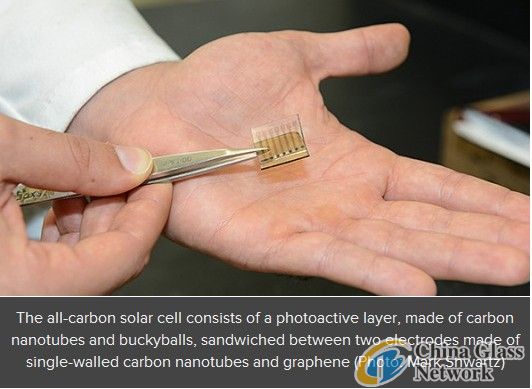Post Time:Nov 05,2012Classify:Glass QuotationView:763

Researchers at Stanford University have developed an experimental solar cell made entirely of carbon. In addition to providing a promising alternative to the increasingly expensive materials used in traditional solar cells, the thin film prototype is made of carbon materials that can be coated onto surfaces from a solution, cutting manufacturing costs and offering the potential for coating flexible solar cells onto buildings and car windows.
Stanford graduate student Michael Vosgueritchian, who is co-lead author of the study, says that while other groups have previously claimed to have developed all-carbon solar cells, the “all-carbon” component of these other cells was limited to the middle active layer. In comparison, the entirety of the Stanford solar cell, including the electrodes, is made from carbon materials.
In place of the expensive conductive metals, such as silver and indium tin oxide (ITO), used in the electrodes of typical silicon solar cells, the Stanford researchers, led by Professor Zhanan Bao, used graphene and single-walled carbon nanotubes, which boast impressive electrical conductivity and light-absorption properties.
Like the
MIT’s proof of concept devices achieved an efficiency of only 0.1 percent and Stanford’s prototype can only claim a laboratory efficiency of less than one percent, which is far short of the efficiencies seen in conventional silicon solar cells. However, Bao says, “with better materials and better processing techniques, we expect that the efficiency will go up quite dramatically."
The main problem is that both the MIT and Stanford carbon-based prototype solar cells primarily absorb light in the near-infrared part of the spectrum. To improve efficiency, the Stanford team is experimenting with carbon nanomaterials that can absorb more light in a broader range of wavelengths, including the visible spectrum.
They are also looking at ways to enhance the smoothness of the solar cell as, “roughness can short-circuit the device and make it hard to collect the current,” says Bao. "We have to figure out how to make each layer very smooth by stacking the nanomaterials really well."
Despite the inefficiencies compared to traditional solar cells, there are some conditions in which carbon solar cells can outperform conventional devices. Since materials made from carbon remain stable in air temperatures of almost 1,100° F (593° C), they can perform in extreme conditions.
"We believe that all-carbon solar cells could be used in extreme environments, such as at high temperatures or at high physical stress," says Vosgueritchian. "But obviously we want the highest efficiency possible and are working on ways to improve our device."
Source: www.usgnn.comAuthor: shangyi